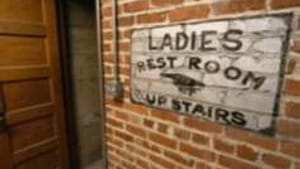Stay in the Loop
BSR publishes on a weekly schedule, with an email newsletter every Wednesday and Thursday morning. There’s no paywall, and subscribing is always free.
A woman's curse (at least in Philadelphia theaters)
A few words about ladies' restrooms

There is a special urgency in the moment that the lights come up for intermission at some of Philadelphia's most venerable theaters. The applause at the end of the first act presages the closest thing to a stampede that you'll ever see among sophisticated patrons of the arts.
This is no equal opportunity stampede. As the men stretch and look around, the women pour into the aisles.
Observe, for example, the main stairway at the antiquated St. Stephen's Theater during the first 40 seconds of intermission. Ever since the Lantern Theater took up residence there, women have dashed down those steps with an almost primal intensity, barging past a heavy door, a strangely claustrophobic hallway, and then another heavy door. Several thousand years of cultural restraint fail to restrain us from elbowing each other out of the way toward our goal: a pair of toilets that seem old enough for William Shakespeare to have used personally.
Yes, for the theater-going women, life is one big race to the ladies' room. By the time she's 80, the average American woman will have spent 18 months waiting in line for the restroom—or something like that.
Everything about the process conspires against us. Not only do we need the facilities more often than men do, it takes us nine times as long once we get in there.
It's time for somebody to say publicly what Philadelphia women have been muttering to each other in the line for years. The ladies' rooms at many Philadelphia theaters are deplorable.
Saloon-style doors
For theater-going Philadelphia grande and not-so-grande dames, intermission is too often a litany of ill-lit restrooms barely 10 feet across, consisting of only two or three stalls, often shielded from view only by rickety saloon-style doors with thin wooden slats that barely come down to your knees, and secured with flimsy hook-and-eye latches that you can barely see in the gloom. (It goes without saying that these restrooms from hell are utterly inaccessible to anyone who uses a wheelchair.)
This discomfort is compounded by posted signs that provide encyclopedic lists of what not to flush and admonish the user to hold down the handle for several seconds and avoid flushing too many times in quick succession.
I've been to Fringe shows in basements or a half-constructed house, and on one memorable occasion, in a warehouse where nothing but a curtain separated me from the rest of the world. But you expect that because, hey, it's the Fringe.
On the other hand, at a 1912 gem of a theater like Plays and Players—aka the Twelfth Circle of Ladies'-Room Hell—not only is a ladies' room of just a few rickety stalls located at the bottom of a steep, narrow, twisting, low-ceilinged staircase, but the men's room stands directly opposite the lounge; so as you see the house lights flicker to signal the second act before you're barely halfway through the line, you can observe the men trotting happily in and out of their facility as easily as frogs skipping in and out of the pond.
(I'm told that the Plays and Players men's room isn't exactly the Taj Mahal, either. BSR editor Dan Rottenberg, who lives just two blocks from that theater, says he walks home at intermission if he feels nature calling.)
Ahhh, Suzanne Roberts!
To be sure, new theaters like the Suzanne Roberts offer a gracious and spacious bank of well-maintained stalls. The Walnut's main ladies' room may be down the stairs, but at least things move briskly and there's room for us to exit the area without squeezing up against the women still waiting in line. The Academy of Music's last renovation expanded its restroom facilities and even added a few extra venues for women.
And you can imagine the excitement that rippled through St. Stephen's on opening night this month—not only for the Lantern's new production of Romeo and Juliet, but especially for the debut of a third (albeit microscopic) ladies' toilet in a corner space formerly used as a kind of janitor's closet. Of course, after washing their hands, users of this new fixture must then fight their way back through the successive doorways and down the passage, still clogged by the ladies who failed to make it down the stairs so quickly.
Forgive me if all this seems in terrible taste. After hundreds of visits to Philadelphia theaters, I can't hold it in any more.♦
To read responses, click here.
This is no equal opportunity stampede. As the men stretch and look around, the women pour into the aisles.
Observe, for example, the main stairway at the antiquated St. Stephen's Theater during the first 40 seconds of intermission. Ever since the Lantern Theater took up residence there, women have dashed down those steps with an almost primal intensity, barging past a heavy door, a strangely claustrophobic hallway, and then another heavy door. Several thousand years of cultural restraint fail to restrain us from elbowing each other out of the way toward our goal: a pair of toilets that seem old enough for William Shakespeare to have used personally.
Yes, for the theater-going women, life is one big race to the ladies' room. By the time she's 80, the average American woman will have spent 18 months waiting in line for the restroom—or something like that.
Everything about the process conspires against us. Not only do we need the facilities more often than men do, it takes us nine times as long once we get in there.
It's time for somebody to say publicly what Philadelphia women have been muttering to each other in the line for years. The ladies' rooms at many Philadelphia theaters are deplorable.
Saloon-style doors
For theater-going Philadelphia grande and not-so-grande dames, intermission is too often a litany of ill-lit restrooms barely 10 feet across, consisting of only two or three stalls, often shielded from view only by rickety saloon-style doors with thin wooden slats that barely come down to your knees, and secured with flimsy hook-and-eye latches that you can barely see in the gloom. (It goes without saying that these restrooms from hell are utterly inaccessible to anyone who uses a wheelchair.)
This discomfort is compounded by posted signs that provide encyclopedic lists of what not to flush and admonish the user to hold down the handle for several seconds and avoid flushing too many times in quick succession.
I've been to Fringe shows in basements or a half-constructed house, and on one memorable occasion, in a warehouse where nothing but a curtain separated me from the rest of the world. But you expect that because, hey, it's the Fringe.
On the other hand, at a 1912 gem of a theater like Plays and Players—aka the Twelfth Circle of Ladies'-Room Hell—not only is a ladies' room of just a few rickety stalls located at the bottom of a steep, narrow, twisting, low-ceilinged staircase, but the men's room stands directly opposite the lounge; so as you see the house lights flicker to signal the second act before you're barely halfway through the line, you can observe the men trotting happily in and out of their facility as easily as frogs skipping in and out of the pond.
(I'm told that the Plays and Players men's room isn't exactly the Taj Mahal, either. BSR editor Dan Rottenberg, who lives just two blocks from that theater, says he walks home at intermission if he feels nature calling.)
Ahhh, Suzanne Roberts!
To be sure, new theaters like the Suzanne Roberts offer a gracious and spacious bank of well-maintained stalls. The Walnut's main ladies' room may be down the stairs, but at least things move briskly and there's room for us to exit the area without squeezing up against the women still waiting in line. The Academy of Music's last renovation expanded its restroom facilities and even added a few extra venues for women.
And you can imagine the excitement that rippled through St. Stephen's on opening night this month—not only for the Lantern's new production of Romeo and Juliet, but especially for the debut of a third (albeit microscopic) ladies' toilet in a corner space formerly used as a kind of janitor's closet. Of course, after washing their hands, users of this new fixture must then fight their way back through the successive doorways and down the passage, still clogged by the ladies who failed to make it down the stairs so quickly.
Forgive me if all this seems in terrible taste. After hundreds of visits to Philadelphia theaters, I can't hold it in any more.♦
To read responses, click here.
Sign up for our newsletter
All of the week's new articles, all in one place. Sign up for the free weekly BSR newsletters, and don't miss a conversation.

 Alaina Johns
Alaina Johns